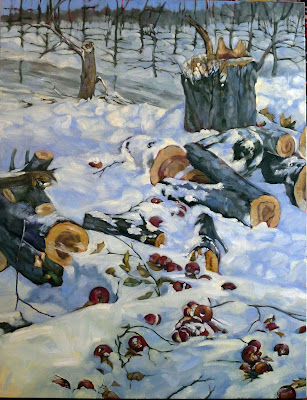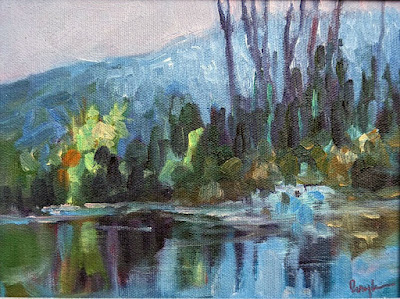It’s easy to forget I’m a painter when I’m up to my elbows in minutiae, but it has to be done. Still, so does painting or I’ve lost my raison d’etre.
 |
| Clary Hill Blueberry Barrens, Carol L. Douglas. This is one of the pieces I’ve decided (provisionally) should go to New York. Until I change my mind again, that is. |
I’ve taken to carrying my to-do list around on my phone. This is probably good organizationally, but it burns a hole in my pocket. As is the way with to-do lists, it never gets any shorter. The advantage of lists on paper is that they’re easier to lose.
I had a visitor in my studio at the first of the year. “I’m drowning in admin,” I told her, as an explanation for the disorder. She’s a successful businesswoman and was, frankly, incredulous. “Admin what?” she asked. After all, I’m an artist. Everyone knows art isn’t about business.
 |
| At least they’re neat. That’s not always true. |
In fact, it’s totally about business. That’s something you need to know if you’re contemplating crossing from amateur and professional status. It’s about taxes and inventory and planning shows a year or more in advance. It’s very easy to fall into a trap where your painting occupies less and less of your time, while you become more of an entrepreneur. If you want to make a living as an artist, the business of art has to be front-and-center in your consciousness.
I talked to Ken DeWaardon Wednesday. He was booting around Port Clyde looking at stuff (an important part of the plein air painter’s job, and best done with a cup of gas-station coffee in hand). I was torn. It was heavily overcast and pissing snow. On the other hand, talking to him was the closest I’d gotten to a brush all week.
 |
| There’s a queen-sized bed under all that stuff. By the time I was done, I had paintings stacked in all three bedrooms and the bathroom. |
I was pulling every single painting out of my storage closets, choosing inventory for an upcoming show at the Rye Art Center in New York. It doesn’t open until March, but a good solo or duo show requires a lot of advance preparation. The paintings—which are huge—have come down to my studio, where their frames will get a beady-eyed examination before they’re wrapped for shipping.
Tom and Peggy Root have a show at Ringling College, called Parallel Visions: The Paintings of Tom + Peggy Root. “I told the art handlers that if somewhere in Georgia they are overtaken by a car with flashing lights, it just means I’ve changed my mind again about another painting,” said Tom. That indecision is a powerful impulse.
Once art gets to a certain point, ‘good’ or ‘bad’ or ‘brilliant’ is irrelevant. The real question is whether they support the narrative. Then there is the question of how the work will hang together. Paintings have to get along with their neighbors.
Meanwhile, the fiscal year has ended. People ask me why I do my own taxes. I counter that the tax preparation is the easy part (and I have Laura Turner to answer all my esoteric questions). It’s the record keeping that kills me. Today my 2019 records go up in the attic, to be replaced by pristine 2022 folders. It’s easy, but it takes time.
 |
| Sometimes all you have time for is a quick watercolor doodle, but that’s better than nothing. |
It’s easy to forget I’m a painter when I’m up to my elbows in minutiae, but it has to be done. Still, so does painting or I’ve lost my raison d’etre.
After I talked to Ken, I gave myself a good shake and went into my studio, where I spent 15 minutes with my watercolors, doing a quick-and dirty-sketch for 45 Day Triple Watercolor Challenge. That’s a Facebook group my students started last year to get us out of the doldrums. If I don’t need it right now, who does?
































